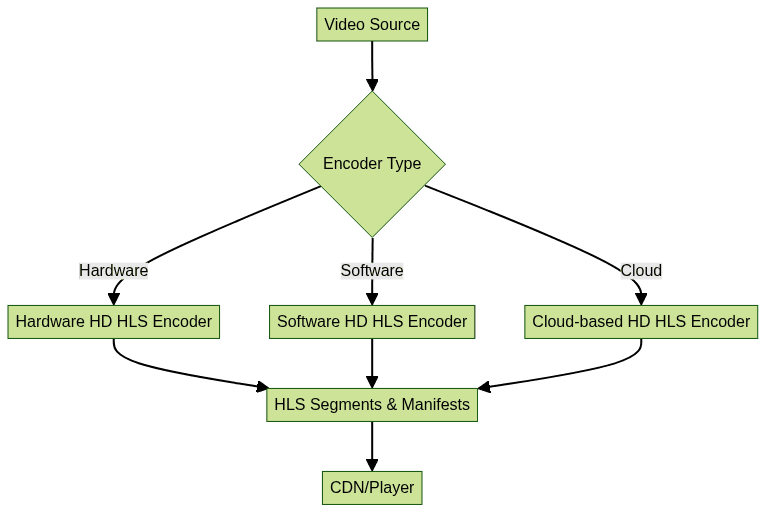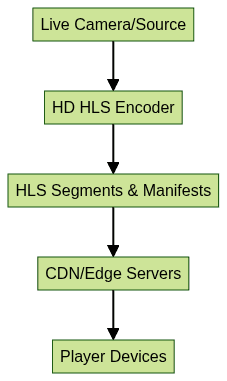The Ultimate Guide to HD HLS Encoders
Introduction to HD HLS Encoders
An HD HLS encoder is a specialized software or hardware solution that converts high-definition video sources into HTTP
Live Streaming
(HLS) format, enabling seamless video delivery across multiple devices and networks. As video consumption continues to surge in 2025, HLS streaming has become the default protocol for OTT platforms, IPTV services, live event broadcasting, and enterprise video solutions. HD HLS encoders are pivotal for delivering adaptive, buffer-free, and high-quality streams to viewers worldwide.From live sports to corporate webinars, HD HLS encoders are used to transcode, package, and deliver video content in real-time. Their ability to support adaptive bitrate streaming, multi-audio tracks, subtitle embedding, and integration with CDNs makes them indispensable for modern streaming workflows. Whether you’re building an OTT service, streaming live events, or deploying IPTV, understanding and selecting the right HD HLS encoder is fundamental to success.
How HD HLS Encoders Work
HD HLS encoders operate by ingesting video from sources such as SDI, HDMI, or IP streams, encoding it with modern codecs (like H.264/AVC or H.265/HEVC), and packaging it into HLS-compliant segments and manifests. The encoder manages bitrate control, audio processing, and subtitle multiplexing to optimize playback on any device. For developers looking to add real-time communication features, integrating a
Video Calling API
alongside HLS streaming can enable interactive experiences within your platform.Supported input formats include:
- SDI, HDMI, RTMP, SRT, MPEG-TS, and more.
Popular codecs:
- AVC/H.264: Industry standard for HD streaming
- HEVC/H.265: Efficient compression for 4K/8K
- MPEG-2: Legacy workflows
Output formats:
- HLS (HTTP
Live Streaming
) - DASH (Dynamic Adaptive Streaming over HTTP)
Typical workflow: Video is ingested, encoded, segmented, and output as a series of
.ts or .m4s files with accompanying manifests (.m3u8 for HLS).FFmpeg HLS Encoding Example
1ffmpeg -i input.mp4 -c:v libx264 -preset veryfast -crf 22 -c:a aac -b:a 128k \
2 -f hls -hls_time 4 -hls_playlist_type vod output.m3u8
3This command ingests
input.mp4, encodes the video to H.264 and AAC audio, segments it for HLS, and outputs a VOD playlist.Choosing the Right HD HLS Encoder
When selecting an HD HLS encoder, it’s important to consider how it will integrate with your broader video infrastructure. For example, if you want to
embed video calling sdk
into your application for seamless conferencing alongside live streams, ensure your encoder and platform support such integrations.Hardware vs. Software vs. Cloud Encoders
- Hardware encoders: Purpose-built devices with dedicated chips (ASICs or FPGAs) for real-time, low-latency encoding. Ideal for high-density, mission-critical workflows (e.g., broadcast studios, live sports).
- Software encoders: Run on general-purpose servers, offering flexibility and easy updates. Suitable for on-premises deployments, development, and smaller-scale operations.
- Cloud encoders: Fully managed, scalable encoding services ideal for OTT and multi-platform delivery, reducing infrastructure overhead and enabling global reach.
Performance Considerations
Key factors include:
- Channel density: Number of simultaneous streams per encoder.
- GPU acceleration: Leverages NVIDIA or AMD GPUs for faster transcoding (especially HEVC/H.265).
- RAM/CPU requirements: Higher resolutions and bitrates require robust server specs.
If you’re building mobile streaming or conferencing apps, exploring
webrtc android
solutions can help you deliver low-latency, real-time video experiences on Android devices.Reliability and Failover
Modern encoders offer redundancy (N+1, active-active) and failover mechanisms to minimize service interruptions. Remote management and monitoring are essential for troubleshooting and uptime.
Cost of Ownership
- Hardware: High upfront cost, low operational overhead.
- Software: Lower entry cost, scaling depends on server resources.
- Cloud: Pay-as-you-go, OPEX model, but potential for higher long-term costs with volume.
Encoder Workflow Comparison

Key Features of Modern HD HLS Encoders
Modern HD HLS encoders are often used in combination with interactive streaming technologies. For example, platforms built with
flutter webrtc
can leverage HLS for scalable broadcast while enabling real-time communication for mobile users.Adaptive Bitrate Streaming
HD HLS encoders generate multiple renditions of a stream at different bitrates and resolutions. This enables adaptive bitrate streaming (ABR), where the player switches streams based on network conditions for uninterrupted playback.
Multi-Audio and Subtitle Support
Support for multiple audio tracks (e.g., languages, commentary) and embedded/subtitle files (CEA-608/708, WebVTT) enhances accessibility and reach.
Low Latency Streaming
Low-latency HLS (LL-HLS) reduces glass-to-glass delay, vital for interactive and live events. Encoders optimize segment size and playlist updates for minimal delay. If your project requires building a web-based video chat or live event platform, integrating a
react video call
solution can complement your HLS workflow for real-time engagement.Redundancy and Failover
Encoders provide automatic failover, redundant power, and network interfaces to ensure high availability.
Remote Management and Monitoring
Modern encoders offer web-based interfaces, APIs, and SNMP integration for configuration, monitoring, and automated alerting.
Adaptive Bitrate FFmpeg Example
1ffmpeg -re -i input.mp4 \
2 -filter_complex "[0:v]split=3[v1][v2][v3]; \
3 [v1]scale=w=1920:h=1080[v1out]; \
4 [v2]scale=w=1280:h=720[v2out]; \
5 [v3]scale=w=854:h=480[v3out]" \
6 -map [v1out] -c:v:0 libx264 -b:v:0 5000k \
7 -map [v2out] -c:v:1 libx264 -b:v:1 2500k \
8 -map [v3out] -c:v:2 libx264 -b:v:2 1000k \
9 -map a:0 -c:a aac -b:a 128k -f hls \
10 -hls_time 4 -hls_playlist_type vod \
11 -var_stream_map "v:0,a:0 v:1,a:0 v:2,a:0" \
12 -master_pl_name master.m3u8 \
13 -hls_segment_filename "v%v/fileSequence%d.ts" \
14 v%v/prog_index.m3u8
15This command generates three adaptive HLS renditions (1080p, 720p, 480p) with a master playlist.
Implementation: Step-by-Step HD HLS Encoder Setup
For teams looking to build robust video platforms, leveraging a
Video Calling API
can add interactive communication features that complement your HLS streaming setup.Hardware and OS Requirements
- For software encoders: Linux (Ubuntu, CentOS), Windows Server, or macOS
- Recommended specs: Multi-core CPU (Intel Xeon/i9 or AMD Ryzen/EPYC), 16GB+ RAM, SSD storage, optional NVIDIA GPU for HEVC
- For hardware: Dedicated encoder appliance with SDI/HDMI/IP inputs
Encoder Setup (Open Source & Commercial)
- Open source: FFmpeg, GStreamer, OBS Studio
- Commercial: MainConcept Live Encoder, Bitmovin Live Encoder, MediaExcel HERO, StreamBuilder
Input Configuration
- SDI/HDMI card (Blackmagic, AJA)
- IP streams (RTMP, SRT, UDP)
If you want to add real-time video communication to your workflow, you can
embed video calling sdk
directly into your web or mobile application for a seamless user experience.Output Configuration
- HLS output directory and manifest location
- Multiple renditions for ABR
- Optional: DASH output for multi-platform compatibility
Integrating with CDN and Players
- Upload segments/manifests to CDN origin (Akamai, AWS CloudFront, Fastly)
- Ensure player compatibility (HLS.js, Shaka Player, JW Player, Safari, Android/iOS)
For mobile and cross-platform streaming, integrating
flutter webrtc
orwebrtc android
can help achieve low-latency, interactive video alongside HLS delivery.Example Encoder Config File (YAML)
1input:
2 source: "/dev/video0"
3 format: "sdi"
4output:
5 hls:
6 path: "/var/www/hls/"
7 segment_time: 4
8 playlists:
9 - name: "1080p"
10 video_bitrate: "5000k"
11 resolution: "1920x1080"
12 - name: "720p"
13 video_bitrate: "2500k"
14 resolution: "1280x720"
15 - name: "480p"
16 video_bitrate: "1000k"
17 resolution: "854x480"
18 master_playlist: "master.m3u8"
19End-to-End Streaming Workflow

Top HD HLS Encoder Solutions & Tools
The HD HLS encoder ecosystem offers diverse options for every use case. If you’re building a platform that requires both streaming and real-time communication, consider solutions that support
Video Calling API
integration for a unified experience.| Encoder | Features | Codecs | Platforms | Pricing |
|---|---|---|---|---|
| MainConcept Live | ABR, multi-audio, real-time, LL-HLS | H.264, H.265 | Win, Linux | Commercial |
| Bitmovin Live Encoder | Cloud-native, ABR, 4K/8K, DRM | H.264, H.265 | Cloud, Win, Lin | Commercial |
| MediaExcel HERO | Hardware/software, redundancy, ABR | H.264, H.265 | Appliance, SW | Commercial |
| StreamBuilder | OTT focus, monitoring, multi-output | H.264, H.265 | Win, Linux | Commercial |
| FFmpeg (Open Source) | Flexible, scriptable, cross-platform | Most | Win, Linux, Mac | Free |
Each solution offers a balance of performance, cost, scalability, and feature set. Commercial encoders often provide support, advanced monitoring, and easier integration, while open source tools like FFmpeg are highly customizable but require technical expertise.
Best Practices for HD HLS Encoder Deployment
- Optimize encoder settings for target devices and networks (bitrate, resolution, GOP size)
- Monitor encoder health and streaming metrics (using SNMP, APIs, dashboards)
- Secure your streams with HTTPS, token authentication, and origin restrictions
- Plan for redundancy and disaster recovery (active-active encoders, backup power/network)
Conclusion
HD HLS encoders are the backbone of high-quality, reliable, and scalable video streaming in 2025. By understanding the workflow, choosing the right solution, and following best practices, you can deliver optimized streams for any application—OTT, IPTV, or live events. Assess your specific needs and invest in the right encoder to future-proof your streaming workflow. If you’re ready to get started,
Try it for free
and explore the possibilities of HD HLS encoding and interactive video experiences.Want to level-up your learning? Subscribe now
Subscribe to our newsletter for more tech based insights
FAQ